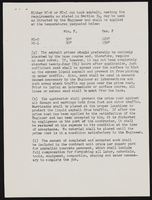Search the Special Collections and Archives Portal
Search Results
Irving Hirshon Photographs
Identifier
Abstract
The Irving Hirshon Photographs are comprised of 55 color slide photographs taken by Irving Hirshon in 1971 of Lake Mead, Hoover Dam, downtown Las Vegas, and the Las Vegas Strip. Hirshon is believed to have taken the slides in the summer of 1971 on a West Coast trip to celebrate his twenty-fifth wedding anniversary.
Archival Collection
Human Radiation Experiments Records
Identifier
Abstract
The Human Radiation Experiments Records (1949-1995) contain reports from the National Environmental Policy Act (NEPA), the Advisory Committee on Human Radiation Experiments (ACHRE), and the U. S. Department of Energy (DOE). Also included are newspaper clippings, a court case brought by the National Association of Radiation Survivors (NARS), and cancer research papers. With the goal of building an atomic bomb using plutonium extracted from uranium, the material also examines the outcomes of radiation exposure done on humans during the late 1940s and early 1950s at the Oak Ridge Nuclear Facility in Tennessee.
Archival Collection
Rochelle Hornsby Papers
Identifier
Abstract
Papers are comprised of newspaper clippings, photographs, and ephemera collected by Rochelle Hornsby about her life in Las Vegas, Nevada during the 1970s and 1980s and her involvement with Temple Beth Sholom. The papers include information about Temple Beth Sholom productions and plays as well as Hornsby's involvement with local sport leagues.
Archival Collection
Maggie Mancuso Collection of Film Locations
Identifier
Abstract
The Maggie Mancuso Collection of Film Locations dates from 1994 to 2001 and consists primarily of color photographs of locations throughout Las Vegas, Nevada for the film
Archival Collection
Johnny Eshow Haig Papers
Identifier
Abstract
The Johnny Eshow Haig Papers (1970-1990) are comprised of contracts, agreements, and correspondence of musician Johnny Haig, who worked as a trombone player and conductor at various hotels in Las Vegas, Nevada from 1955 until 2000. Additionally, the papers house extensive original music scores written by Haig. The papers primarily cover Haig’s later career in the 1970s and 1980s.
Archival Collection
Las Vegas Professional Men's Club Records
Identifier
Abstract
The Las Vegas Professional Men’s Club Records (1984-1997) consist of the constitution, meeting minutes, and organizational documents of the Las Vegas Professional Men’s Club, later known as the Las Vegas Men’s Club (LVMC). The LVMC provided a social outlet for gay men in Southern Nevada. The bulk of the materials date from the 1990s and include membership lists, event fliers, promotional materials, financial documents, and information documenting the club’s fundraising activities.
Archival Collection
Gilbert Buck Papers
Identifier
Abstract
The Gilbert Buck Papers (1930-1986) focus on Buck's work as a surveyor and real estate broker in southern and central Nevada. Included are master reports, designs, standards, flood and drainage reports, and land specifications on water, sewer, and public lands. Papers regarding real estate include reports, housing and mobile home development plans, newsletters, surveys, and Buck Realty negotiations. There are books and information on seminars Gilbert Buck hosted in Las Vegas, Nevada on investing in raw land. Also included are awards, correspondence, newsletters, a scrapbook of Buck's early life, and information on his campaign for governor of the state of Nevada in 1974. There is include some documentation of Buck's real estate and mining interests in South America.
Archival Collection
Earl Rockwell Papers
Identifier
Abstract
The Earl Rockwell Papers (1852-1978) consists of newspaper clippings, diaries, books, correspondence, and ephemera related to Las Vegas, Nevada pioneer Earl Rockwell. The collection documents Rockwell’s life in Las Vegas and Elmira, New York and also contains seven nineteenth-century diaries that belonged to Rockwell’s grandmother, Amanda Brees.
Archival Collection
Kendall Stagg Collection
Identifier
Abstract
The Kendall Stagg Collection (1998-2000) consists of material documenting Kendall Stagg’s political races in northern Nevada and also details gay activism in Reno. The collection consists of Stagg campaign materials, a t-shirt from one of his campaigns, and documents pertaining to the Gay, Lesbian, and Bisexual Student Union at the University of Nevada, Reno and Gay Pride parade organizing in Reno.
Archival Collection

